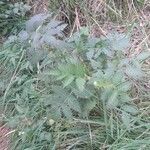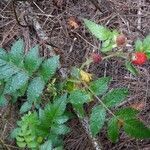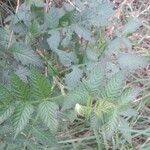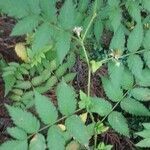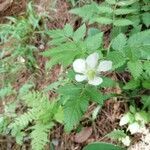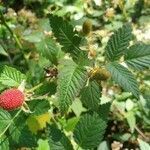Erect, rarely semi-scandent shrubs, up to 3 m high. Stems glabrous, unarmed or prickles few, straight, up to 6 mm. Glands (sub)sessile, some-imes present on leaves and other parts up to the flowers. Leaves imparipinnate, up to 27 cm long, with up to 4 (or 5) opposite pairs of leaflets, petiole 2-6 cm long. Stipules linear, 5-13 by 0.5-1 (-2) mm, entire or sparsely toothed, glabrate. Leaflets elliptic to oblong or ovatish, 2-9(-12) by 1-4 (-6) cm, base usually rounded or cordate, margin serrate, apex acute or acuminate to long-pointed, papyraceous to pergamentaceous, (7-)10-15(-19) pairs of nerves, both sides sparsely hairy mainly on the nerves. Inflorescence lax and wide, up to c. 20 cm long and wide, with up to 7 branches under the terminal flower, the branches thyrsoid to cymes, the entire inflorescence with up to 60 flowers. Bracts lanceolate to 3-partite, up to c. 1 cm. Pedicels up to 5 cm long, glabrous, sometimes with small prickles. Hypanthium 5-6 mm across, glabrous and unarmed outside. Sepals triangular, 7-13 by 3-6 mm, including the 2-5 mm long acumen, entire, glabrous outside but woolly on covered margins. Petals orbicular to elliptic or obovate, 7-12 by 5-9 mm, falling early, glabrous, (greenish) white. Stamens up to more than 100, filaments up to 3 mm, anthers c. 1 mm long. Pistils up to more than 300, ovaries glabrous, torus elevated, basal part without pistils and long-hairy, upper part glabrous, style up to 1.5 mm long. Collective fruits ellipsoid to ovoid, up to 2.5 by 1.5 cm, sepals ultimately recurved. Fruits c. 1.5 by 0.8 mm (dry), (orange-)red, mesocarp a thin layer when dry.
More
Shrubs erect. Branchlets unarmed. Leaves imparipinnate, 5–7-foliolate, rarely 3-foliolate; petiole 2–5 cm, grooved, petiolule of terminal leaflet much longer than those of lateral leaflets, petiolule of lateral leaflets to 5 mm, petiolule and rachis soft hairy; stipules linear, to 1.2 cm; blade of leaflets elliptic to oblong, 3–10 × 2–4 cm, terminal leaflet usually larger than lateral leaflets, lateral veins 10–15 pairs, midvein and lateral veins prominent abaxially, impressed adaxially, abaxially sparsely hairy along veins, adaxially sparsely hairy along midvein, base rounded to slightly cordate, of lateral leaflets often oblique, margin serrate, apex acute to acuminate. Inflorescences usually terminal, cymose panicles, to 14 cm; rachis, pedicels, and bracts often glabrous; bracts lanceolate to oblong, divided at apex. Pedicel 1–3 cm. Sepals triangular-ovate, 6–10 mm, abaxially glabrous except margin tomentose, apex narrowly acute. Petals white, orbicular, 7–12 mm, glabrous. Stamens and pistils many, glabrous. Aggregate fruit red at maturity, globose to ellipsoid, 0.8–1.4 cm. 2n = 14*.
A scrambling shrub reaching 2 to 4 m high. It is armed with fair sized sharp spines. The leaves have leaflets on opposite sides of the stalk with 3 to 11 leaflets. The edges are toothed and they are pointed at the tip and slanting at the base. The flowers are white and the berries borne in clusters. The berries are bright red and fairly juicy but tasteless. The fruit are 0.8-1.4 cm across.
Uses Although many collectors report on their labels that the fruits are tasteless or worse, they are at least in Java collected from the wild and sold for consumption. Heyne Nutt. Pl. Indon. 1950 693 , mentions the use of the leaves in cases of slimy faeces (? dysentery, compare Rubus moluccanus).
More
The berries are eaten raw.
